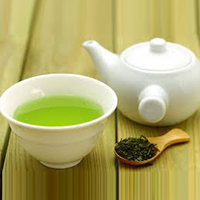Tea is an infusion of flavorful leaves that has been consumed for centuries as a beverage and is valued for its medicinal properties. Today, scientific research has validated its healthful effects and the cup that cheers has gained recognition as the cup that heals.
The tea shrub (genus Camellia, family Theaceae) is a perennial evergreen with its natural habitat in the tropical and sub tropical forests of the world. Cultivated varieties are grown widely in its home countries of South and South East Asia, as well as in parts of Africa and the Middle East. The young shoots or flushes are plucked and processed into green (unfermented), black (fermented), oolong (red, partially fermented) or yellow (partially fermented) teas. In fermented teas, the action of leaf oxidizing enzymes, (mainly aka polyphenol oxidase) convert the tannins and catechins in tea leaves into brown/red colored products1.
Green tea (Camellia sinensis) has been acclaimed for its antioxidant properties, attributed to the presence of catechins such as epigallocatechin gallate (EGCG). These compounds promote health by preventing lipid oxidation and have been proven to possess antibacterial and antiviral action as well as anticarcinogenic and antimutagenic properties.
Chemistry
The catechins in green tea are responsible for its medicinal properties2.
Other biologically active compounds present in green tea include the methylxanthines, theophylline, theobromine and caffeine. Theophylline has been used as a bronchial smooth muscle relaxant in the treatment of asthma and bronchitis.
Biological effects of the catechins in green tea
The biological benefits associated with green tea catechins especially epigallocatechin gallate, are generally attributed to their antioxidant activity2. They are also reported to scavenge free radical oxygen3. In studies with lard or vegetable oil, the tea catechins were found to reduce the formation of peroxides more effectively than dl-a-tocopherol or BHA. The antioxidative activity increased in the following order: EC<ECG<EGC<EGCG. In view of these results, the potential use of the catechins in green tea as effective natural antioxidants in foods has also been explored.
Tea catechins are believed to act as anticancer agents by detoxifying cancer causing substances in vivo 4,5. In vitro studies revealed that catechin gallates selectively inhibit 5 a-reductase. This enzyme is responsible for the conversion of testosterone to 5-a dihydrotestosterone6. 5-a dihydrotestosterone at high levels, has been implicated in the etiology of prostate cancer and male pattern baldness.
Anticancer effects:
The anticarcinogenic effect of green tea extract was studied on mouse skin. Green tea catechins, especially EGCG inhibited each step in the conversion of a cancer to malignancy. Tea was also found to offer protection against chemically induced tumor initiation, promotion and progression to malignancy as well as inhibit skin cancer induced by ultraviolet radiation7.
In mouse models of chemically induced lung and stomach cancer, there was significant inhibition of tumor incidence and proliferation when green tea catechins were orally administered. Oral administration of 0.012-1.25% of EGCG or green tea extract to mice or rats with chemically induced oesophegal, intestinal, colon, liver and mammary tumors was found to have a potent inhibitory effect on carcinogenesis.
Recent studies showed that tea drinking reduced the risk of oesophageal cancer in Chinese women; oral cancer in northern Italians; gastric cancer in Swedish adolescents; pancreatic cancer in elderly Poles and residents of a retirement community in the U.S.; and colon cancer amongst retired male self-defense officials in Japan. It is now generally accepted that tea drinking has chemopreventive effects8.
Antimutagenic effects:
Green tea catechins have been shown to be antimutagenic, lowering the formation of heterocyclic amines9 (formed during the cooking of meat and fish and proven to be mutagenic). They have also been shown to reduce the occurrence of chromosome aberrations during mutagen exposure10.
Protection against atherosclerosis and hypertension:
Lipid peroxidation especially the oxidation of LDL (Low Density Lipoprotein) has been implicated in the etiology of atherosclerosis. In vitro studies confirmed the inhibition of lipid peroxidation induced by cupric ions, by green tea catechins. Green tea extract was found to prevent the increase in serum cholesterol in mice fed high fat diets. A recent cross-sectional study also revealed that in people consuming more than ten cups of green tea per day, there was decrease in serum cholesterol levels, decrease in LDL, VLDL (Very Low Density Lipoprotein) and triglycerides, increase in HDL and reduction in atherogenic index. In the same study, tea consumption was also found to decrease the levels of serum markers of liver damage11. In a study on an elderly group in the Netherlands suffering from coronary heart disease, tea (probably not green tea) was found to reduce the risk of death from this condition12.
The catechins in green tea were also found to inhibit hypertension in mice (resulting from chronic psychosocial causes) through enhanced sedative action of the brain neurotransmitter GABA 13, gamma amino benzoic acid. Green tea was also found to lower the incidence of stroke in the elderly14.
Protection against infectious diseases
The tea catechins (particularly EGCG and EC) were found to have bactericidal properties. They are believed to damage bacterial membranes. Tea has been used in the treatment of diarrheal diseases and infections such as cholera and typhus15. Green tea is also believed to have protozoacidal and virucidal16 (including HIV18) properties. However, the effectiveness of tea catechins in the treatment of human viral diseases needs to be confirmed. EGCG has also been shown to stimulate the immune response, in studies on mice. In this case, the galloyl group in EGCG was postulated to stimulate mouse splenic B-cell proliferation19.
Protection against tooth deca
Green tea catechins are believed to offer protection against tooth decay by three mechanisms:
- a) By killing the causative bacteria, such as Streptococcus mutans17.
- b) By inhibiting the collagenase activity of the bacteria resident below the gum line20
- c) By increasing the resistance of tooth enamel to acid induced erosion21
Promotion of longevity
Tea drinking may promote longevity, as evidenced by the low mortality rates amongst Japanese females who are traditional practioners of the tea ceremony22.
Green tea by virtue of its scientifically validated healthful effects has potential utility in the management of a variety of disorders. This ancient herb, associated with wakefulness and harmony in Buddhist legend, has now found its rightful place in modern alternative medicine as a versatile healer.
References
- Bokuchava, M.A. and Skobeliva, N.I. (1980). The biochemistry and technology of tea manufacture. Crit. Rev. Food Sci. & Nutr. 12 : 303-370.
- Prophylactic functions of tea catechins : Information brochure, Food Research Laboratories, Mutsui Norin Co. Ltd., Japan.
- Zhao, B. et al. (1989) Scavenging effect of extracts of green tea and natural antioxidants on active oxygen radicals. Cell Biophysics, 14 : 175-185.
- Fujiki, M.D. et al. (1992) Anticarcinogenic effects of (-) epigallocatechin gallate. Preventive Medicine, 21, 503-509.
- Bu-Abbas et al. (1995) Stimulation of rat hepatic UDP-glucuronosyl transferase activity following treatment with green tea. Food Chem. Toxicol., 33: 27-30
- Shatsung, L., Hiipakka, R.A. (1995). Selective inhibition of steroid 5-a-reductase isoenzymes by tea epicatechin 3-gallate and EGC3-gallate. Biochem. Biophys. Res. Commun. 214 : 833-838.
- Mukhtar, H. et al. (1992) Anticarcinogenic effects of (-) epigallocatechin gallate. Preventive Medicine, 21, 351-360.
- Schwarz, B. et al. (1994) Coffee, tea and lifestyle. Prev. Med. 23 : 377-384.
- Weisburger, J.H.et al. (1994). Prevention of heterocyclic amine formation by tea and tea catechins. Cancer Lett. 83 : 143-147.
- Sasaki, Y.F. et al. (1993) The aclastogen-suppressing effects of green tea, Po-lei tea and Rooi bos tea in CHO cells and mice. Mutat. Res. 286 : 221-232.
- Imai, K. And Nakachi, K. (1995). Cross-sectional study of the effects of drinking green tea on cardiovascular and liver diseases.Brit. Med. J., 310 : 693-696.
- Hertog, M.G. et al. (1993) Dietary antioxidant flavonoids and risk of coronary heart disease: The Zutphen elderly study, Lancet, 342: 1007-1011.
- Henry, J.P. and Stephens-Larsen, P. (1984) Reduction of chronic psychosocial hypertension in mice by decaffeinated tea. Hypertension, 6:437-444.
- Sato, Y. et al. (1989) Possible contribution of green tea drinking tothe prevention of stroke. Tohuku . Exptal Med. 157 : 337-343.
- Shetty, M. et al (19940 Antibacterial activity of tea (Camellia sinensis) and coffee (Coffee arabica) with special reference to Salmonella typhimurium. J. Commun. Dis. 26 : 147-150.
- Ryu, E. (1982) Prophylactic effect of tea on pathogenic microorganism infection to animals and humans. Int. J. Zoonoses. 9 : 126-131.
- Horiba, N. et al. (1991) A pilot study of Japanese green tea as a medicament: Antibacterial and bactericidal effects. J. Endod. 17: 122-124.
- Nakane, H. and Ono,K. (1989) Differential inhibition of HIV-reverse transcriptase and various DNA and RNA polymerases by some catechin derivatives. Nucleic Acids Research, Symposium series 21, 115.
- Hu, Z. (1992) Mitogenic activity of (-) epigallocatechin gallate on B-cells and investigation of structure-function relationship. Int. J. Immunopharmacol. 14 : 1399-1407.
- Makimura,M. et al. (1993) Inhibitory effect of tea catechins on collagenase activity. J. Periodontol. 64: 630-636.
- Yu, H. Et al. (1995) Effects of several tea components on acid resistance of human tooth enamel. J. Dent. 23: 101-105.
- Sadakata, S. Et al. (1995). Mortality among female practitioners of Chanyou (Japanese tea ceremony). Tohoku J. Exp. Med. 166:475-477.


